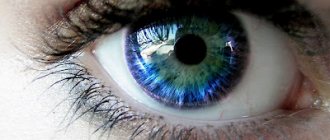There are people who confuse colors and cannot distinguish between individual shades. How do colorblind people see the world around them? Color blindness is a rare disease that is caused by birth defects and cannot be effectively treated. The appearance of such patients is no different from ordinary people, but the health problem is still present. It is difficult to normally perceive the world through the eyes of a colorblind person, but many scientists have devoted entire research to this activity. Let's look at what colors colorblind people cannot distinguish.
Causes of color blindness
Humans naturally have trichromatic vision. What does this mean? In fact, the photoreceptors of the retina perceive waves of only three shades of the spectrum: red, blue, green; the rest of the variety of colors is just their mixed variations in different proportions. The cones (photoreceptors) located in the retina are responsible for color vision. S-type cones are sensitive to the violet-blue spectrum, M-type cones are sensitive to the green-yellow spectrum, and L-type cones are sensitive to the yellow-red part of the spectrum. Their presence and normal activity provide a person with good color perception. If there is an absence or deficiency of any light-sensitive pigments, color vision impairment occurs. There are several types of color blindness.
Interesting facts about color blindness
Here are some interesting facts about color blindness in people that have been studied and clinically described by science at present:
- Color blindness is named after the English scientist John Dalton, who first described one of the types of color blindness based on his own sensations in 1794, because Dalton had protanopia (he did not distinguish the color red). However, John did not suspect his illness until he was 26 years old. Dalton described his vision defect in a small book, after the publication of which the term “color blindness” appeared, which became synonymous not only with the described vision anomaly in the red region of the spectrum, but also with any other color vision disorder.
- Men are more likely to be color blind than women because the genes responsible for the most common forms of color blindness are found on the X chromosome. But since women have two X chromosomes, a defect in one of them is usually compensated by the other, while men have only one X chromosome.
- Color blindness is most often inherited from mother to son.
- Color blindness can be not only hereditary, but also acquired as a result of physical or chemical damage to the eye, optic nerve or parts of the brain.
- People with complete color blindness (achromatopsia) sometimes have problems with decreased visual acuity, and they may also feel uncomfortable in conditions of excess light (both natural and artificial).
- Diagnosis of color blindness is carried out using color tests. In the USSR and in modern Russia, the nature of people's color perception is determined on special polychromatic Rabkin tables - in the set for the test for color blindness there are 27 colored sheets - tables, the image on which consists of many colored circles and dots that have the same brightness, but different in color. To a colorblind person who cannot distinguish some colors in a picture, such pictures will seem uniform and he will not be able to read the numbers on them. But a person with normal color perception is able to accurately distinguish numbers or geometric shapes on polychromatic cards from the Rabkin test.
- Another test for color blindness in humans is a test invented by a Japanese ophthalmologist named Shinobu Ishihara, but there are other methods for testing color blindness, including genetic tests.
- There is no cure for color blindness, but special lenses help people with red-green color blindness in bright light, such as EnChroma® color blind glasses. At the same time, the potential possibility in the future of treating color blindness using genetic engineering methods is predicted (but this is not yet possible).
- In some countries, people suffering from color blindness are not accepted for certain jobs: aviation pilots, train drivers, military service, etc.
- In Romania and Turkey, people with color vision impairment are not issued a driver's license. But in the Russian Federation, colorblind people with dichromacy have the right to obtain a driver’s license, but only categories A and B (without the right to work for hire), this opportunity has appeared since 2014 after the entry into force of the Government of the Russian Federation of December 29, 2014 N 1604 “ On lists of medical contraindications, medical indications and medical restrictions on driving.” Only the issuance of a driver's license to people suffering from achromatopsia (code H53.51 according to the International Classification of Diseases ICD-10) is prohibited in the Russian Federation.
Did you know that the color blue is accurately perceived by most people, including those suffering from most types of color blindness? That is why the interface of the world's most popular social network Facebook is made in blue colors, because the creator of this social network, Mark Zuckerberg, suffers from color blindness. That is why other popular sites and programs are trying to make their interfaces primarily in colors that would be visible even to colorblind people.
Monochromacy
A pathology in which the patient is able to perceive the world around him in only one color. This happens because the retina has a single type of photoreceptor, and the other two are missing. The disease is usually congenital, and people suffering from it are called monochromats. Depending on what types of cells are damaged (cones or rods), monochromasia is divided into several varieties.
1. Rod monochromasia (achromatopsia). In this case, the cones are completely absent. It's like looking at a black and white TV and seeing different shades of gray.
2. Cone monochromasia. With this disorder, two types of cones are absent in the retina, and all the colors of the surrounding world are perceived in any one color of different saturation:
- cyanopsia - in blue;
- chloropsia - in green;
- erythropsia - cones are able to recognize only red color;
- xanthopsia - vision in yellow shades.
Basics
The best explanation I found for how and why we see colors is this nice five minute video from Calder Hansen:
As this video explains, we perceive colors thanks to photoreceptors in our eyes (also known as cones ), which respond to specific wavelengths of light. We have three types of these cells: some are sensitive to light waves close to red, others to green, and others to blue. If one of these types of cells does not work properly, the person has color weakness . If they do not work at all, color blindness results ( color blindness ).
So, there are different types of color blindness and three different types of color weakness—one for each cone type. There is also achromatopsia - color blindness in the literal sense. A person with achromatopsia cannot distinguish any colors. None of the cones work, only the perception of illumination remains. This is a fairly rare occurrence, so I will not discuss it in this article.
Color weakness
Let's take a look at what the world looks like for people with color weakness . Keep in mind: the line between healthy vision and impaired vision is not very clear. Your readers with color weakness may see some colors better or worse:
It's as if these colors have been applied with an Instagram filter - but they can still be distinguished from each other. Red, green, blue and yellow are different from each other. Color weakness is more common than color blindness: 6-7% of men[2] have some type of color weakness.
Their names may seem complicated, but they are actually just Greek words meaning “first,” “second,” and “third,” combined with the word “anomaly.” Thus, protanomaly means “first anomaly,” deuteranomaly means “second anomaly,” and tritanomaly means “third anomaly.” The sequence of colors is the same as in RGB: red, green and blue. So the first anomaly - protanomaly - is a violation in the perception of red color.
Color blindness (color blindness)
Let's turn to colorblind people . They have one type of cone that is damaged, causing red, green or blue color blindness. People with good vision see 10 million colors, while colorblind people see fewer.
Types of color blindness are named by analogy with color weakness, except that they end in -anopia. a- means “not”, and -opia means “vision”, so the word “anopia” can be translated as “lack of vision”:
This is a more serious vision impairment because colorblind people cannot distinguish certain colors. Readers who are red and/or green color blind cannot distinguish the difference between red and green or orange and light green. For readers who are color blind to blue, it looks the same as green.
The good news is that color blindness is rare; at least less common than color weakness. Only about 2-3% of men are colorblind.
Treatment of monochromasia and social aspects
If a person has monochromasia, there are limitations in some areas of activity. Thus, he cannot drive a car or engage in many activities that require distinguishing colors - costume designer, designer, military man, driver, etc.
At the same time, monochromatic children can attend a regular secondary school, however, parents need to warn teachers about the presence of this feature in the child.
Congenital monochromasia, alas, cannot be treated. Therapeutic actions are usually aimed at eliminating nystagmus and photophobia - they are often characteristic of people suffering from this pathology. At the same time, their visual acuity is reduced (especially with achromatopsia) and special glasses are prescribed to improve it.
Diagnosis and treatment
In most cases, color blindness is discovered accidentally during an examination by an ophthalmologist. To detect deviations, special color tables (Rabkina, Schaaf, Ishihara) and tests are used. With their help, the type of color blindness and its degree are determined.
You can also check color perception at home. The essence of testing is based on the properties of different shades. The table contains circles that differ in color and brightness. They contain numbers, letters, and figures. Only a person with normal vision can make out an object in a color mass.
If there is color blindness, the patient will see other encrypted objects that are inaccessible to the normal eye. The quality of testing is influenced by many external factors: fatigue, lighting level, age, etc. And, although the reliability of the tables is quite high, sometimes it is necessary to conduct additional examination using an anomaloscope.
The essence of the test is that the patient needs to select shades located in different visual fields.
To date, it is impossible to get rid of the anomaly. This feature remains with a person for life, so it is necessary to learn to live with it. But active development is underway to introduce the desired pigment into the cone. There are also plans to release special glasses for colorblind people on the shelves of optical stores, which will help them see the world in the “correct” color palette.
| An acquired disease can be successfully combated. This is especially true when taking medications. Sometimes it is enough to stop taking medications or choose an alternative to restore correct color perception. |
Return to contents
Tritanopia
Tritanomaly, as this type of partial color blindness is otherwise called, is characterized by inability to distinguish shades in the blue-violet region of the spectrum. Tritanopia is associated with the absence in the retinal rods of the photosensitive pigment cyanolabe, which is responsible for color perception in the blue-violet region. This pathology occurs less frequently than all other dichromatic pathologies: less than 1% in men and women. Unlike green and red color blindness, this disorder does not depend on gender, as it is caused by a mutation in the 7th chromosome.
Shades of yellow are seen by Tritanope as blue; he cannot distinguish purple from red, but he does not confuse purple and green. However, instead of blue and purple colors, the patient may see brown or gray. However, visual acuity remains normal, and no changes in the fundus are observed. This type of color blindness cannot be treated.
Anomalous trichromasia
With normal vision, all three pigments are located in the cones. If any of them is missing, anomalies occur. A visual defect is considered to be a lack of pigmentation, as a result of which the patient distinguishes colors, but cannot perceive them brightly enough. This is a rare type of disease that occurs in a small percentage of colorblind people.
This is how colorblind people see a traffic light:
Cyanopsia
A color perception disorder in which a person cannot see the green and red filter. The patient perceives the world in blue tones.
A distinctive feature of the pathology is the lack of inheritance. It occurs only in the presence of disease or damage to the eyes or brain. It appears when there are disturbances in the lens or its damage. It ceases to perform its function, as a result of which the retina receives many light rays.
Chloropsia
Impaired perception of incoming light rays, as a result of which a person does not see the entire spectrum. The world is perceived in green tones. The disease is not inherited. Occurs when there is a malnutrition of eye tissue, inflammatory diseases of the retina, or acute poisoning.
A characteristic feature of the condition is the deterioration of the patient’s well-being. Gradually, visual acuity decreases. Photophobia appears. A person begins to see fewer shades. At this stage, it is recommended to consult a doctor to avoid complications such as tissue damage.
Erythropsia
Perception of the world in red tones. Blue and green filters are not visible. The perception of the white shade changes greatly, which becomes yellow. Erythropsia does not occur with hereditary color blindness. It begins after surgery on the eyeball, when exposed to bright light on the retina, especially when examining white snow.
If there is no obvious damage to the eye tissue, the condition resolves quickly. No therapeutic measures are carried out. An ophthalmologist may prescribe sunglasses, which will protect the retina. It is recommended to wear them at any time of the year, especially if your eyes are very sensitive to bright light.
Color blindness is a fairly rare disease. Many believe that it disrupts the perception of green and red shades. But that's not true. There are many subtypes of the disease that are important to diagnose early. Some of its manifestations occur only in the presence of damage or disease. This condition is treatable. Timely detection of the disease increases the success of corrective procedures.
Author's rating
Author of the article
Alexandrova O.M.
Articles written
2031
about the author
Was the article helpful?
Rate the material on a five-point scale!
If you have any questions or want to share your opinion or experience, write a comment below.
Deuteranopia
Like tritanopia, it occurs in only 1% of people - this is a reduced sensitivity to colors in the green spectrum. It is also called “green color blindness”. In this case, deuteranopes have a deficiency of the chlorolab pigment. Photoreceptors do not detect waves in the green-yellow part of the spectrum. Green mixes with pink, orange and shades of red, and red mixes with green and brown, violet is perceived as blue, and purple as gray.
Deuteranope sees a blazing sunset as blue-green, the rays of the setting sun as blue, and the sun's disk appears green. The leaves on the trees are blue or dirty brown for him. In modern ophthalmology there is no cure for this type of color blindness. However, visual acuity in people suffering from deuteranopia is normal.
Features of dichromasy
Protanopia
Protanopia occurs when red cones are absent or damaged.
This is a hereditary abnormality that affects approximately 1% of all men. At the same time, red colors appear dark gray to a person, violet colors do not differ from blue ones, and orange colors appear dark yellow.
Deuteranopia
Caused by the absence or improper functioning of green cones.
A person cannot distinguish the green spectrum from yellow and orange. The red color is also very difficult to distinguish.
The video below shows how colorblind people with deuteranopia see.
Tritanopia
An extremely rare type of color blindness in which there is no blue pigment. Occurs when the seventh pair of chromosomes is damaged. In this case, blue appears green, purple appears dark red, and orange and yellow appear pink.
Protanopia
A deviation in which it is impossible to distinguish shades of the red spectrum. The cause of the pathology is the absence or deficiency in the photoreceptors of the retina of the photosensitive pigment erythrolab, which is responsible for the perception of waves of the yellow-red spectrum. Lime and light green colors are perceived by protanopes as orange (yellow-red), purple is indistinguishable from blue. However, they differentiate blue from green, and green from dark red. Protanopia is the most common type of dichromasia. It affects 8% of men and 0.5% of women. There is no treatment for the congenital form of the anomaly. If it is acquired, appropriate therapy can be prescribed.
If protanopia is present, the patient may have some limitations in professional activities and in society. The color red plays a big role in the human environment. People with such a disorder will not be able to obtain many professions: driver, pilot, sailor, railway worker, doctor, designer, etc. However, if this is not related to work, then in general this anomaly does not particularly affect the quality of life, although there are still some difficulties. For example, it is not easy to navigate when choosing clothes or interior items. Not long ago, category A driving licenses were approved for protanopes.
Hostages of colors
Fortunately, poor color discrimination does not affect visual acuity in any way. A person can live to an old age and not even realize that he has any problems.
It’s another matter if a colorblind person goes into chemist or electronic engineering, where mixing up the color of wires or reagents is life-threatening. The loss of color perception is also fatal for the artist. One of the most striking examples of this is the tragedy that happened to the famous artist Savrasov, the author of the famous painting “The Rooks Have Arrived.” Having suffered from a serious infectious disease, the great master of landscape at the end of his life ceased to distinguish colors and painted his last creations “from memory.”
Vrubel was also color blind. Scientists came to this conclusion after analyzing the composition of his paintings, painted mainly in pearl-gray tones. The great artist suffered from red and green color blindness.
How is color blindness diagnosed?
The most popular and effective way to determine different types of color vision impairment is Rabkin’s polychromatic tables, consisting of 27 pictures. Figures and numbers are made from small colored circles against the background of the same circles, but of a different color. You are given 5 seconds to look at each picture.
People suffering from color blindness either do not distinguish numbers at all against a motley background or recognize only part of the pictures - a specialist determines from the answers what type of pathology is present. Also, for the diagnosis of color vision disorders, other versions of tables have been developed: polychromatic tables of Stilling, Fletcher-Gamblin, Ishihara, Schaaf. A modern way to detect color blindness is electroretinography.
Famous people suffering from color blindness
The most famous person with color vision disorder is John Dalton . It was he who, back in 1794, began to describe this pathology, based on his own feelings.
For some individuals, color blindness has not become an obstacle to creativity. These include the famous artist Vrubel . His paintings lack green and red shades; they are all painted in pearl gray tones.
The French painter Charles Merion was also colorblind, which did not prevent his graphic creations from captivating viewers with their beauty.
It is unknown how the life of the famous singer George Michael if not for color blindness. Since childhood, the artist dreamed of becoming a pilot, and after it was discovered that he was color blind, he began to study music.
Christopher Nolan is also colorblind , which did not prevent him from achieving world fame.
Treatment of color blindness
To date, there is no cure for congenital color blindness. If the pathology arose as a result of any other diseases, then there is a chance of correction. So, for cataracts, a lensectomy operation is performed: replacing the natural clouded lens with an intraocular lens. Thus, color perception returns to normal. Some other causes of color blindness can also be eliminated.
For patients with a congenital form of the disease, modern ophthalmology can so far offer only two types of correction. For example, Ningaloo Colorblinds contact lenses from Gelflex (Australia). They contain five types of filters that allow you to fully perceive the world. The model is presented in two colors - blue and brown, and has a traditional wearing period. At the same time, the lenses are capable of correcting myopia up to – 6 diopters and hyperopia up to + 6 D.
There is no point in wearing them at the computer - the glasses do not improve color perception on the screen. There are currently three models on the market, the most popular of which are EnChroma and Pilestone. They can be purchased in online stores, however, be careful - beware of fakes.
Measures for adaptation of colorblind people in society
Of course, some people who have been color blind since birth have a hard time. Moreover, special glasses are designed for use outdoors or in any similar bright lighting. And even if the teachers at school or institute are not against the child using glasses in art lessons or in any other cases when determining the color will be important for the educational process, it is unknown how peers will react to this. Therefore, parents should work with a colorblind child from an early age. The purpose of this work is to protect the future teenager and adult from acquiring various complexes. Psychologists advise, first of all, to perceive yourself as you are, and even emphasize that you are unique.
In addition, people with congenital color blindness must immediately be prepared for the fact that the path to certain professions is closed to them. Among them are the following: sailor, high-altitude builder, pilot, military man, chemist and others. Colorblind people cannot always obtain a driver's license, and if they are given one, it is only category B with the possibility of using the car for personal purposes. A person suffering from color blindness will not be allowed to work as a driver.
The best way that psychologists recommend is to prepare the child from childhood for these circumstances. When he is older, you need to tell him about some famous people suffering from color blindness who have achieved success in life despite such a disease. Among them is the artist Vrubel, who, although he painted black and white paintings, could convey details very accurately, and thereby became famous. Singer George Michael, although he dreamed of becoming a pilot, could not fulfill this desire. Therefore, soon switching to music, he became a famous artist. John Dalton became a famous researcher due to the fact that he himself discovered deviations in the perception of color, described what color colorblind people most often do not distinguish, and gave impetus to other scientists to study the organs of vision in this matter more deeply.











